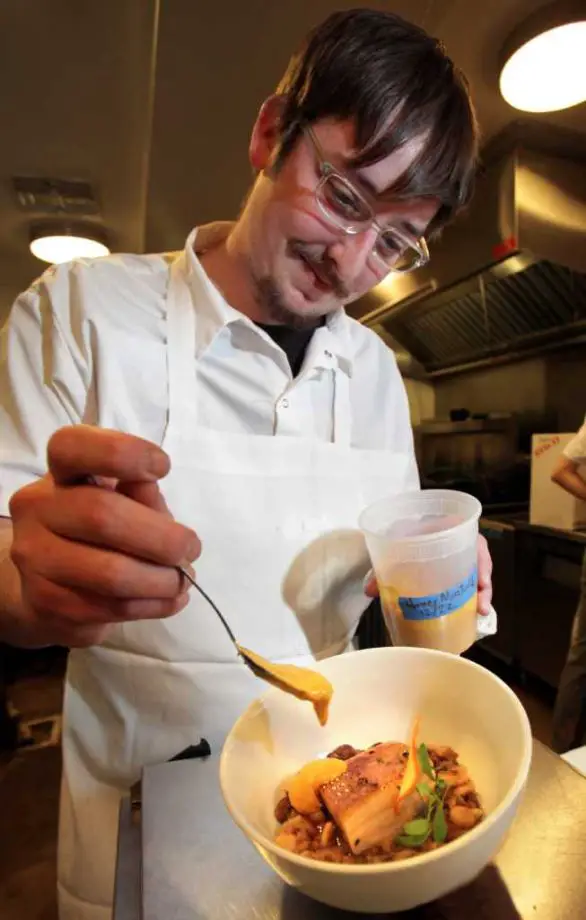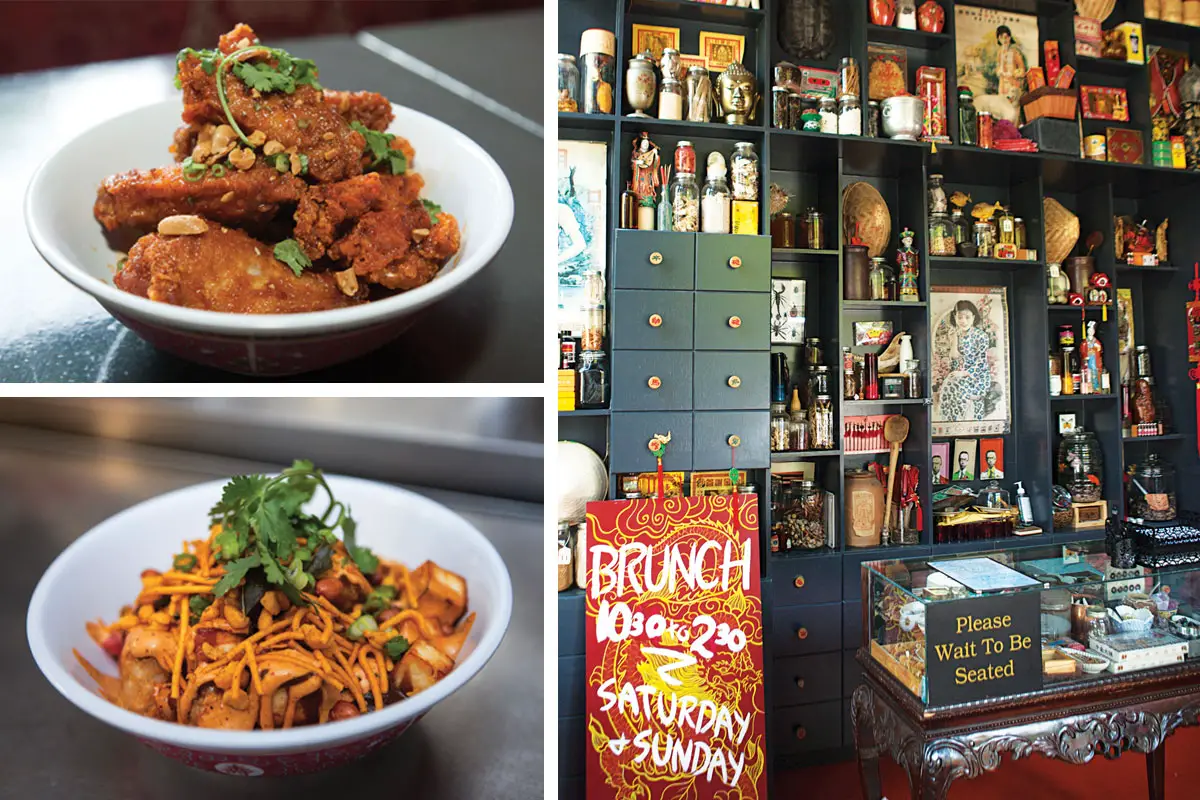I won’t do this often, I promise, but there’s one word that you need to know, and that word is bathos.
It describes a specific kind of juxtaposition (some definitions use “anticlimax” as a synonym) where the highbrow and lowbrow intentionally collide, e.g.: “The ballerina rose gracefully en pointe and extended one slender leg behind her, like a dog at a fire hydrant.”
Hot Joy is bathetic. Many great restaurants are. Its food is an intentional mash-up of sophistication — in their technique yes, but primarily in their ingredients — and populism, again in their ingredients, but also in the informal, chillwave vibe of the restaurant. And the result of this ying-yang marriage — a litter of remarkably delicious inter-cuisine offspring like Spam-Fried Rice and Mac ‘n’ Cheese Ramen — is nothing short of a textbook best of both worlds situation.
Chef Quealy Watson, the self-deprecating and whip smart tinkerer behind the curtain, opened Hot Joy after working at the beloved but now-defunct Monterrey in San Antonio.
In 2014, in one of the rare instances where something that’s called life-changing actually does change a life, “Bon Appetit’s” Andrew Knowlton placed Hot Joy on its Top Ten Restaurants in the Country list, famously calling Watson’s cuisine “dude food” and “stoner snacks.” Then, as publicity begets more publicity, “stoner food” became the go-to epithet for anything made by a chef with an impressive CV and something with Fritos on the menu.
While Watson himself doesn’t partake, he understands Knowlton’s reasoning for the titles. And while I also find the description helpful, it’s a smidge misleading.
Not that either of us is taking Knowlton literally — no one in their right mind would think that a stoner could cook any of Hot Joy’s dishes. But the phrase does have the unfortunate side-effect of downplaying the amount labor and meditation that go into Watson’s food.
In a lot of ways, cooking is like writing. You have to learn the rules before you’re allowed to break them. And in that vein, Watson’s cooking is a lot like Hemingway, in that its approachability isn’t a sign of childishness or simplicity, it’s a sign of mastery.
Making exotic food accessible, finagling scary ingredients like kecap manis and crab fat into friendlier forms with familiar faces like sour chili ranch, tomatillo jaew and dark roux dashi, is a lot like how the expression “coming full circle” means that the first and last stages of a process look the same but couldn’t be farther apart.
Watson’s “stoner food” might look like undressed, trashy delight, and it might have all the religious toothsomeness of a 2am pilgrimage to Waffle House, but make no mistake—it takes more work to make great food look unassuming than it takes to just make great food.
It raises the question, though — what’s with the bathos then? If you’re going through all this effort to make the food, why not throw on linens and kidskin gloves and charge $40 for a re-reinterpreted Caprese and rake in the cash with bulldozer? Good question.
A sizable chunk of the explanation is that part of Watson’s raison d’être deals with divorcing the association that people have between sophistication and quality, i.e. showing people that fancy things aren’t always good.
Or more specifically, that non-fancy things are often good. The result is a menu that looks working class but tastes bourgeois, like the restaurant version of Matt Damon in “Good Will Hunting.”
And if you’re scratching your head looking for the missing part of the Working Class Ingredients + Something = Good Food equation, look no further—the answer lies in the Labor (or Labour). Non-luxury ingredients keep the overhead low, but they need a lot of finesse and coaxing to blossom into workably delicious end products, so that’s just what they get.

“We’re still not expensive,” says Watson, “but I still consider it fancy because we put a lot of work into everything. You can make a braised short rib at a French restaurant really easily, but since putting together a red curry is more complex but less expensive, people don’t consider it fancy. We try and make food that anybody can come in and order.”
So if you’re a penniless young academic in San Antonio (or a penniless visitor, or a penniful fan of good food), the appeal of Watson’s food becomes immediately apparent.
The back-of-house squad puts in an immense amount of work to make humble ingredients luxurious, which means everything on the menu stays unreasonably affordable, and not the “This is affordable gold” kind of affordable, but the kind of affordable you can take home to mom.
More importantly, we at Study Breaks are firm believers in the teach a man to fish philosophy, and Watson et al.’s cooking shows how you can make inexpensive things delicious if you know what you’re doing.
And since you probably don’t know what you’re doing, we’ve included recipes for two of Hot Joy’s most famous creations: Migas Fried Rice and the Crab Fat-Caramel Chicken Wings.
The idea for the Migas Fried Rice came from a game that Watson and his staff play to keep their creative juices flowing. The rules are simple: Imagine the worst possible iterations of dishes—birthday cake fried rice was thrown around, or Cheetos Queso (my idea).
But when sous chef Chris Cheatwood suggested turning a Thai dipping sauce called jaew into a Tex-Mex flavor base for migas, the idea didn’t sound like a joke at all. Plus the recipe doesn’t call for much skin in the game—all you need are some vegetables, a blender, rice and eggs and you’re set.
When we spoke, Watson mentioned offhand that Ferran Adria had once said that a pear can taste just as good as slice of foie gras. It might not be as expensive, but it doesn’t taste any better or any worse, just different. In the hands of a creative chef, especially one who understands the sort of invisible potential of foods—the underlying flavor of things that ingredients themselves really only represent—taste turns from a luxury you buy into a quality you create.
And since there’s no better place to see that principle in action than at Hot Joy, either use these recipes to game the system, or if you’re in San Antonio, stop in and thank us later








